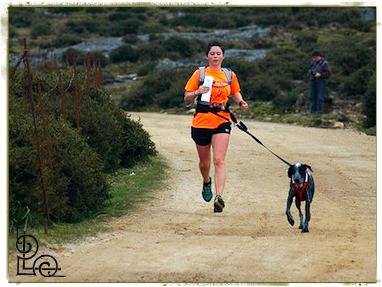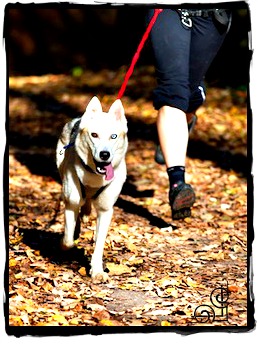What Is Canicross?
Canicross, otherwise known as canix, is a sport fairly unknown to most people. This is slowly changing, though, as it’s a great dog sport that really doesn’t require much other than you and your dog!
The problem of how to keep sled dogs or dogs who do skijoring fit during the off season led to the development of this dog sport, so initially, it was mostly working dog breeds that trained for this sport.
Luckily for all of us, today, almost any breed or mixed breed can and does participate!
Dogs love to run, and they also love to be with their people. So it's a given that most dogs will enjoy canicross. Obviously, if you or your dog aren't used to running, you'll need to train and work up to longer distances gradually.
Equipment You’ll Need
The awesome thing about canicross is that there isn’t a huge investment in equipment. Technically, you could simply clip your leash on to your dog’s collar, tie up your sneakers and head out.
But if you want to amp up your game a bit, it really is worthwhile to purchase a few tools to make it even more safe and fun:
- Canicross belt - this is so that you can run hands-free. The belt secures snugly around your waist, which then attaches to a line connected to your dog.
You can get one with or without leg straps - it’s really a personal choice. The leg straps are good for strong pulling dogs or fast runners, as it helps you stay upright when your dog is pulling, and the pull will be more from underneath your behind as opposed to your lower/mid back.
- Bungee line: this is used to attach yourself to your dog. They range from 7 to 12 feet, and can be attached to one or two dogs. It’s important to have a line with a built-in bungee, as it absorbs the shock for both of you when the line is jerked and pulled.
Keep in mind what length to buy - about 2 meters is usually good for most dogs. You don’t want it so long that it drags on the ground, but you also don’t want it too short that it pulls up on your dog’s back.
- Dog harness: like I said, a harness is safer for your dog than wearing a collar, as the pulling can damage his neck and throat. There are different styles and sizes of harness available. The x-back harness is most common, and is designed to let the dog pull from the chest, with weight being dispersed across the back.
How should your dog’s harness fit? You should be able to fit two fingers between the harness and your dog’s body, with no restriction of his ribs or chest. If you notice him wheezing or running “off-balance”, chances are that it isn’t fitting properly!
- Good running shoes: something lightweight and quick drying that will give you good traction on the trails is best.
Get Ready... Set... Go!
Anyone can start canicross - handlers can be young or older, fit or new
to exercise. Even disabled persons can join in this sport!
For dogs, it’s important to wait until they are at least one year old
before starting canicross. Their bones and bodies are still growing
before this age, and you can really damage them by intense exercise.
Large breed dogs take longer to finish growing, so if you’re unsure, check with your vet to get the A-Okay.
Before starting running, it’s a pretty good idea to teach your pooch some helpful commands.
That way, you won’t find yourself tangled in the line, or being dragged face-down in the mud because your dog didn’t understand that you wanted him to stop, not speed up!
These commands closely resemble those used for dog sledding. They are:
- Go left - "haw"
- Go right - "gee"
- Go forward or faster - "hike"
- Slow down or stop - "whoah" or "steady"
- Stand still facing forward - "line out"
Word to the wise - try not to use treats to teach your dog the commands, as you want him to
be facing forward, not cranking around to look for a cookie whenever
you give him a command.
It’s also important that you teach your dog to always keep a bit of tension on the line, so that it doesn’t drag on the ground and become a tripping hazard.
While some might say that it’s useless to try to train your dog to heel if he’s used to pulling you from in front, it is possible to do, and even beneficial.
Take for instance if you are running downhill... if your dog continues to plow on ahead, there’s a pretty darn good chance that you’ll go for a dive. Because of this, you want to be able to tell your dog to heel when necessary.
As for regular walk time, dogs are way more intelligent than we think sometimes. If you’re consistent with the rules, he’ll learn that when the harness is on he should be pulling, and when a collar is on he should be heeling beside you.
Once you have gotten those two main rules underway, you can start to introduce the heel command while your dog is in harness as well sometimes. The trick to avoid sabotaging his nice heeling while on a collar? Don’t ever allow him to go ahead of you or pull while his collar is on.
Safety Precautions!
Be careful of running in the heat! It’s mostly a warm weather sport, so you should always watch your dog carefully for signs of exhaustion or heat stroke. Water often, and try running in the early morning or evening as opposed to the heat of the day.
Pavement can be really hot and hard on a dog, so try to stick to running on natural surfaces. Dogs with flat noses, such as Bulldogs, will have trouble with this type of sport, as they can’t breathe as well as other dogs due to the shape of their nose.
One last safety precaution - do NOT try to use any type of anti-pull harness when running with your dog! There have been studies done on this, in particular by Dr. Christine Zink (DVM, PhD, DACVP, DACVSMR), showing that these harnesses are detrimental to a dog's structure and gait.
Being restrictive by design, you should never make your dog wear one of these while running as it can increase the risk of injury. Not to mention the fact that in canicross, you DO want your dog to pull you!
Upping the Ante - Canicross Competitions
Got a competitive streak? There are lots of canicross clubs and organizations worldwide, so find one local to you that you can start training with.
It’s fun to do this sport with others, and if you work with other teams while training, it adds an element of competition to help you improve.
The UK has quite a number of competitions, with a large listing of them on the official website of CaniCross UK. Canicross and bikejoring both started in Europe, and are very popular there. The sport is gaining popularity in North America, though!
In Canada (my neck of the woods), the Bristol Dryland Canadian Championship Dog Race is a big event held yearly in Quebec that includes canicross, bikejoring, scooters and larger teamed dog rigs. It draws competitors from around the globe to the small town of Bristol.
|
Generally to compete, dogs must be 12 months or older, as it can be harmful to race a dog who is still growing. For the same reasons, dogs must be 18 months or older to compete in distances longer than 10 miles. When at a race, race management can and will cancel the race if the temperature is 25º C or higher. You’re still allowed to do the course, but there is no competition allowed. |
 Canicross is for all breeds and people! Canicross is for all breeds and people!Photo courtesy of Certo Xornal via Flikr. |
This may vary from race to race, but there is usually a rule like this in place for everyone’s safety. Often, when temperatures are above 20º C, the race organizer must be sure to have water points throughout the course, as well as a pool or cool towels for the dogs at start and finish.
Whether you like to run already, or have always wanted to run, canicross is a fantastic sport that lets you and your dog run together. The health benefits alone make it worthwhile to try!
And unlike many other dog sports, this one doesn't require a lot of expensive equipment or months of training.
I am definitely not a runner unless there is a spider nearby, but if I was, this would be the sport for me! Would you and your best friend give canicross a try?
- Home
- Dog Sports
- Canicross


